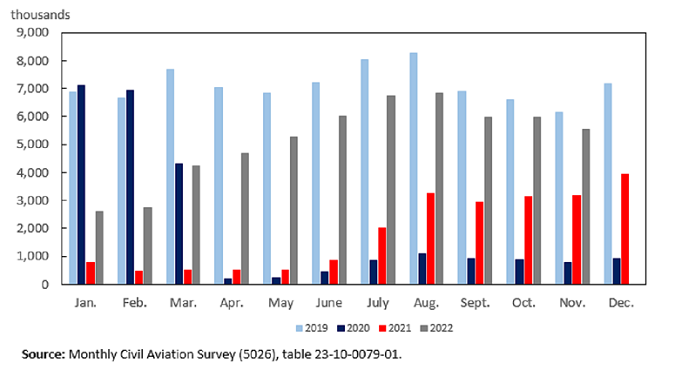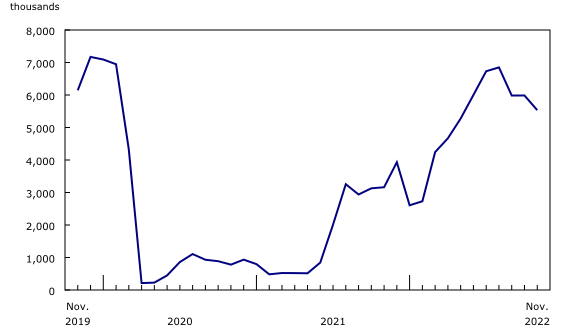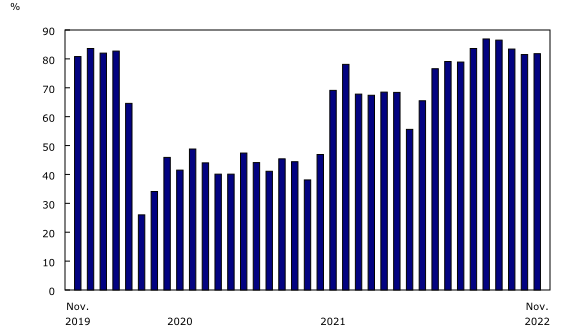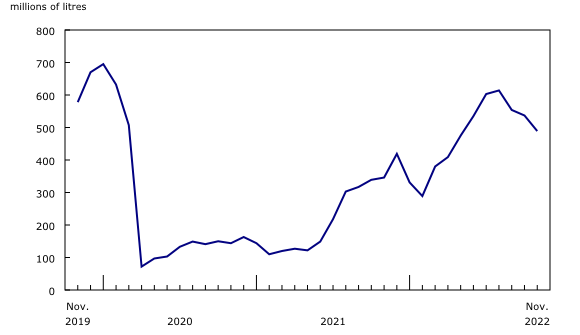Monthly civil aviation statistics, November 2022
Released: 2023-01-26
Highlights
Major Canadian airlines carried 5.5 million passengers on scheduled and charter services in November, 75.0% more passengers than in the same month of 2021 and 90.1% of the November 2019 level, before the COVID-19 pandemic.
With traffic at 13.9 billion passenger-kilometres and capacity at 17.0 billion available seat-kilometres, the passenger load factor (the ratio of passenger-kilometres to available seat-kilometres) was 81.8% in November, comparable with pre-pandemic levels.
The $1.7 billion operating revenue earned in November was 98.7% of that earned in November 2019.
Between summer and winter travel seasons
November typically tends to have the lowest passenger numbers and load factors of the year. In 2022, January was the month with the fewest passengers and lowest load factor due to the impact of the Omicron variant. While November had fewer passengers than October, it had more than any of the first five months of the year.
On March 11, 2020, COVID-19 was declared a pandemic by the World Health Organization. In the months that followed, Canadian air travel remained well below historical levels. Unless otherwise specified, comparisons for a given month are made with the same month in 2019 (also referred to as "pre-pandemic levels"), when airline activity levels were in line with historical trends.
Recovery stable in November
Canadian Level I air carriers flew 5.5 million passengers on scheduled and charter services in November, reaching 90.1% of the pre-pandemic level reported in November 2019, similar to the 90.6% in October (compared with October 2019).
With traffic at 13.9 billion passenger-kilometres and capacity at 17.0 billion available seat-kilometres, the passenger load factor was 81.8% in November 2022, one percentage point higher than in the same month in 2019.
Each passenger travelled an average of 2,513 kilometres in November. The average distance was above (+0.7%) the pre-pandemic level for the first time.
At 146,000, the number of flying hours in November was 86.4% of the pre-pandemic level.
Operating revenue earned by Level I air carriers totalled $1.7 billion in November 2022, amounting to almost 99 cents for every dollar earned in the same month in 2019.
Note to readers
The Monthly Civil Aviation Survey covers all Canadian Level I air carriers: Air Canada (including Air Canada Rouge), Air Transat, Jazz, Porter, Sunwing and WestJet (including Swoop, WestJet Encore and WestJet Link).
The average passenger trip length is calculated by dividing the number of passenger-kilometres by the number of passengers. Trips across Canada and around the world are included in this calculation.
The data in this monthly release are not seasonally adjusted.
Contact information
For more information, or to enquire about the concepts, methods or data quality of this release, contact us (toll-free 1-800-263-1136; 514-283-8300; infostats@statcan.gc.ca) or Media Relations (statcan.mediahotline-ligneinfomedias.statcan@statcan.gc.ca).
- Date modified:





